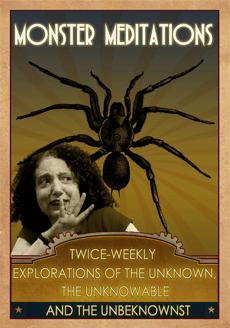It’s not unusual for me to be drawn across three galleries at the Met Museum when I spy a couple of Caravaggios in the distance. The Italian painter with a back-story worthy of an epic novel (including a murder, brawls and conflicts with patrons) created images with powerful narratives.
In paintings like “The Denial of Saint Peter” (at the Met) the story told in the picture is well known. To his contemporary audience, the purpose of his paintings was to retell important tales that were very much a part of their culture and common knowledge: “David and Goliath”; “Judith Beheading Holofernes”; “Rest on the Flight From Egypt” and many others didn’t need Wikipedia explanations — his audience knew the stories.
What happens when the familiar story is stripped away from the images? Whether it’s by a naïve viewer or by someone who simply allows the figures in the paintings to reveal alternative narratives? This is very exciting. An entire new world opens up. The three characters in deep conversation in “The Denial of Peter” share an intense connection. What are they talking about?
Every picture tells more than one story!
http://www.metmuseum.org/collection/the-collection-online/search/437986





I remember seeing a Caravaggio exhibit when I was last in Rome–2002 perhaps. Amazing to say the least.
The Caravaggios in ROMA!!!
I made a fetish out of seeing as many as I could. The ones in the Churches — especially in the Piazza del Popolo knocked me over like a sucker punch to the imagination. I kept spinning and spinning ideas!
That is part of the fun of exploring art and such. We have an opportunity to explore the stories it gives to us from our own interpretation.
Aside from anything they might have left behind in their own notes and such all we have is our own interpretations of what they left behind.
For modern art, that’s definitely the case. The observer supplies the context. But for artist’s like Caravaggio, most of her work was done to communicate a particular story for a particular patron. The wonder is that now — all those years later — we can imbue the work with these other stories. Basically make it up from his inspiration and not be tied to the biblical tale his patrons commissioned. That is so much FUN!
Maybe this is how some works of creativity become universal – not just because they have themes we can all relate to, but themes we can discover for ourselves.
YES!
I’ve had that experience with operas and, oddly enough, with movies on airplanes when I saw but didn’t hear the dialog. I think I’d better explain… When there are titles at the opera (the Met Opera company has little screens in front of each seat and you can turn on — or off — the translation of the libretto) it’s hard to find your own story in the music, acting and sets, BUT I remember seeing an unfamiliar opera in Florence and interpreting the singing and scenes on my own. It was like the times I didn’t bother with the headsets and the movie was projected to the entire cabin. I know that some movies I understood all-too-well as they were obvious but others were somehow BETTER!?
We can, and do, pick up on the relationships but maybe the subject of the dialog is different. In that particular Caravaggio masterpiece, the sense of betrayal and fear and guilt and intensity is on their faces. The soldier is inquiring and he is scary. The topic of the conversation could be something else. I can even imagine a contemporary situation in which the solider is asking the ordinary citizens a threatening question. Do you know this man? Are you a conspirator? It could be in any place with a civil war or anyplace with a dictatorship — and that is a lot of places around the world.
Being open to various interpretations is what makes art, books, and music so fulfilling. There are varying degrees of interpretation, but no “correct” interpretation per se (though sometimes people do grasp for straws.) I like to look at paintings without reading about them first. I’ll go to great pains not to look at the little info cards until I can see what spin I might put with an image. When one really takes hold, that’s when I’ll read all about it. Granted, my art history background isn’t very extensive 😉
I studied art history and I still read the cards AFTER I see the picture. I also avoid the headset commentaries unless it’s an exhibit about archeology (with fragments of assorted stuff) or something that I feel that I need an expert whispering in my ear. I hate that whisper whisper whisper and sometimes I disagree with the “expert” hahaha and get angry.
Art has to speak for itself! When I visit museums or galleries with visual artists they look — really look — before they check out the “credits.” A while back I went to gallery hopping with a painter friend from my gym. She’s older than me and from England. She studied art in Liverpool in the early 1970s. We walked into a gallery in Chelsea (NY not London) and she immediately said this sculptor studied at blah in the 70s and was influenced by blah and did blah… NONE of that information was on display, but she confirmed it all with the gallery assistant on our way out the door. Now THAT’s an at education! LOL